
Comparisons
The XACT S1 becomes even more impressive when comparing it to the Antipodes Oladra running in UPnP/MPD mode, using its USB output, and being controlled by the JPLAY app. The Oladra is one of the select few servers that I encountered that sounds organic via USB. As the company’s flagship product, it carries a very serious price tag, which makes the S1 seem almost affordable.
To start the comparison of the two servers, I used both using their native footers, placed directly on the same HRS EXR rack, and powered with the same power cables. For the time being, I left the XACT S1 connected via the XACT Phantom network- and USB cable while using the Oladra with my default network cable and Mad Scientist Prime USB cable. As regular readers will know, Antipodes servers have always excelled in sounding smooth, lush, and organic, and the Oladra is the culmination of this. But to my astonishment, in these respective configurations at least, the two servers sounded more alike than different.
Both servers excel in presenting the music in an effortless, fluid, well-saturated, free-flowing, and emotionally engaging manner, and in these areas, the two are rather evenly matched. Where the two differ is in the balance between relaxed creamy smoothness on the one hand, and agility, crispness, and expression on the other. The Oladra basks in the former, while the XACT S1 lands between the midpoint and the latter of the two extremes. Both servers are deeply musical, but the Oladra is rounder, sweeter, and more forgiving, whereas the XACT S1 is crisper and more revealing.
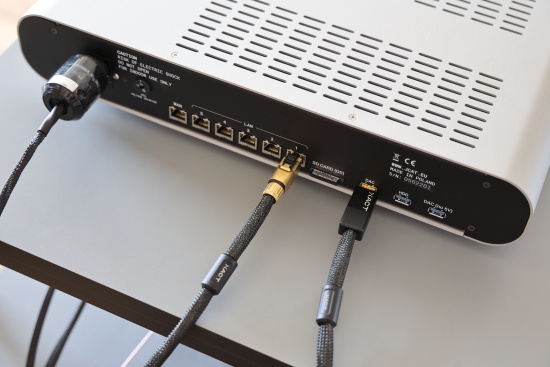
So far, I have been using the XACT Phantom LAN and XACT Phantom USB cables with the XACT S1. Meanwhile, the Oladra was used with one of my standard (but carefully selected) Cat 6 ethernet cables, which I use for all my network audio components, and my current favorite USB cable, the Mad Scientist Prime USB. Now, it was time to investigate the impact of the XACT Phantom LAN and XACT Phantom USB cables.
First, I swapped the XACT USB cable for the Mad Scientist Prime USB. This was interesting, as there were, again, certain commonalities between the two cables. Both cables deliver a full-blooded and profoundly musical delivery, and neither cable adds anything in the way of artifice or clinicality. But there are noteworthy differences. Specifically, the XACT Phantom was more fluid, light-footed, relaxed, airy, and refined, whereas the Mad Scientist was more sonorous, robust, impactful, and expressive. Having identified these differences, I re-compared the two servers using the same USB cable, but this had little impact on the server’s differences that had already been identified.
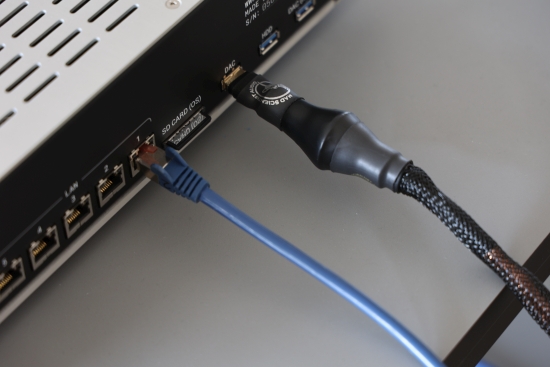
Next, I swapped the XACT Phantom LAN cable that was connected to the XACT S1 for one of my standard Cat 6 ethernet cables. Oh, boy, that made quite the difference! For better or for worse, the standard cable provided a leaner, more articulate, more direct, and more expressive delivery. Granted, it was definitely not as smooth, liquid, or full-bodied and arguably less organic, but for my taste and system circumstances, the standard cable provided a more exciting balance, which I preferred. This is not to say that my standard cable performs the same as the Phantom LAN, far from it, in fact!
The XACT Phantom LAN cable is pivotal in enhancing the server’s inherent smoothness and organic nature. As such, it becomes an important tool that can be used according to taste. Add the XACT Phantom LAN for maximum liquidity and smoothness, or use another cable for enhanced crispness and spriteliness. Now, using the servers under identical circumstances, the difference between the two also jumped from relatively small to very pronounced. Such can be the impact of a network cable!
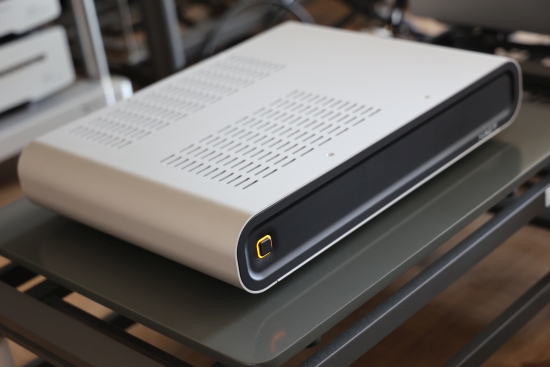
Tweaks
As standard, the XACT S1 sits on compliant rubber-like footers that almost beg to be substituted with upmarket units. Speaking of footers, the XACT website actually announces that Ceramic Footers are coming soon, and I’ll be looking forward to hearing them. Currently, my go-to aftermarket footers are StillPoints Ultra SS V2 and a range of Ansuz Darkz Resonance Control footers, of which the T2 are my favorites. Granted, they cost a small fortune, but they really are much better than any of the Finite Elemente Ceraball variants that I used previously.
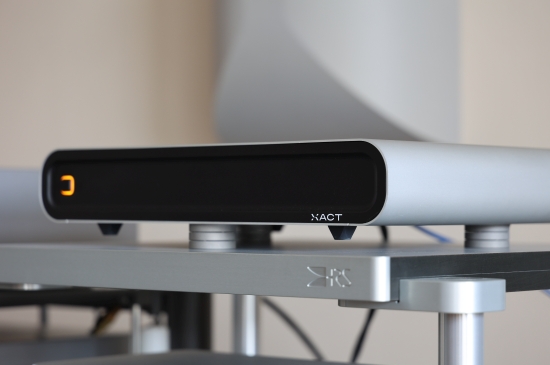
The Oladra’s constrained-layer-damping footers are too tall to allow the use of the Ansuz Darkz, but, as I found earlier, this server works really well with the StillPoints footers, so these are what I used. When also adding StillPoints under the XACT S1, sure enough, the impact was enormous, greatly enhancing the transient sharpness and apparent pacing. But in this case, the StillPoints pulled the sound a little too much in the analytical direction. The Ansuz Darkz T2, on the other hand, provided a balance that I found ideal: subjectively faster, more articulate, and more expressive than with the standard rubber footers but retaining saturation and smoothness.
Now, the XACT S1 impressed me even more. When used with its standard footers, the S1 sounds smooth and unhurried but never slow or smeared. In that sense, it really does indeed represent the best that analog has to offer, but it does not do it in a euphoric, thick, or overly creamy manner. When used with the Ansuz Darkz footers, it retains its innate naturalness and flow, gains excitement and expression, and becomes even more enthusiastic. Used like this, the server sounds exceedingly neutral, transparent, linear, and precise, yet, there’s absolutely nothing technical about the performance. Quite the contrary, as it remains simultaneously beguilingly fluid, airy, and highly refined.
Interim Score
At this stage in the review, it’s clear that the XACT S1 could be viewed quite differently, depending on which cables and footers are used. So, let’s do a quick recap.
When used with its standard footers and with XACT Phantom LAN and USB cables, the sound can be described as representing what is often aspired to as an “analog” reproduction. That is to say, the music flows freely, sweetly, and organically in a liquid manner without any mechanical or artificial nature and no hardness. Used like this, it reminds me of the Antipodes Oladra but with the balance between smoothness and precision changed from the far left to halfway right of the center.
When used with my standard cables and Ansuz Darkz T2 footers, the sound becomes more neutral, articulate, and direct, less smooth, saturated, and organic, but also more revealing and precise. Used like this, it reminds me of the Melco N5-H50 for its neutrality and transparency, but with an even more spritely and expressive nature as well as enhanced liquidity and lyrical involvement.
Clearly, there is a huge advantage for a range of products to be made by the same manufacturer with a single goal in mind. In either guise, the XACT S1 delivers massively. It’s superbly evenly balanced, and thanks to this, it can be tweaked either way, just as preferred.
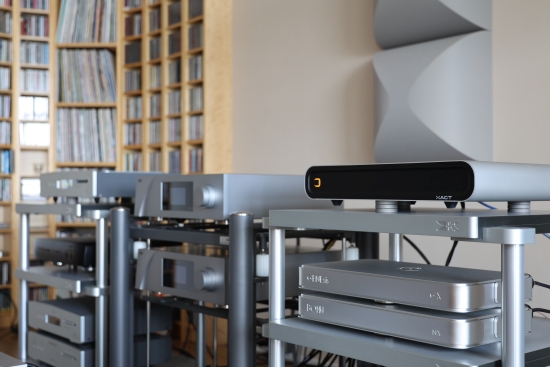
Versus CD
In this day and age, it seems CDs are hardly used anymore. It’s partly a matter of convenience, and I admit to not playing CDs as often as I used to. But still, I find that owning a superb CD transport is a huge benefit. Not just because CD can still sound very good, but also because it is an inherently stable platform. Unlike a certain music software suite, CD players usually do not get a software update every two weeks, after which it’s a guess as to how its sound will have changed.
My transport of choice is the Aqua La Diva M2, and amidst the ever-changing forest of music servers, streamers, and their software, it is my dependable tower of strength. In case of doubt, I can always rely on the player to sound the same as it always did.
Dependability aside, the La Diva M2 remains one of the best digital sources I have heard. It’s only been bettered by servers or streamers in very specific areas but never across the spectrum. Traditionally, and for the longest time, CD used to be better in fluidity, refinement, and air, in other words, the sense of analog flow. But servers have made massive performance leaps in the last handful of years, and the XACT S1 is not the only server that sounds analog-like in terms of liquidity and flow. But there’s more to convincing lifelike sound than that. Spontaneity and transient behavior, for example. It’s not often talked about, but this is what LP can do so incredibly well: being fluid and free-flowing while having immediate transient behavior as well as eternal decay. Given a good recording, LP can truly excel at combining these opposite qualities. But a good CD transport can usually still get closer than most servers. And this is precisely where the XACT S1 sets another benchmark!
Under identical circumstances such as power cable, rack type and position, footers, and digital interconnects that sound as similar as possible, and of course, playing my own CD and its rip, the XACT S1 sounds almost indistinguishable from the La Diva M2. Honestly, it took me the best part of half an hour to try and identify what differentiates the two. But in the end, I could not reliably tell them apart. If that sounds like faint praise, let me add that the Diva M2 possesses an unusually refined performance, which has so far been impossible for any server to deliver via any connection method, and certainly not via USB!
Next: more comparisons and Conclusion
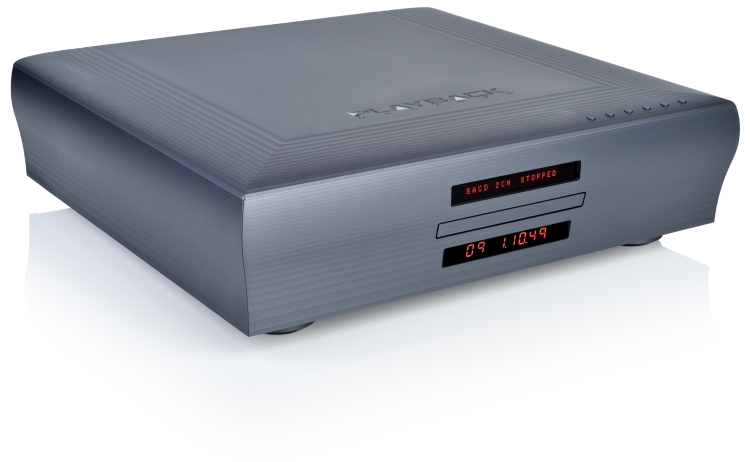






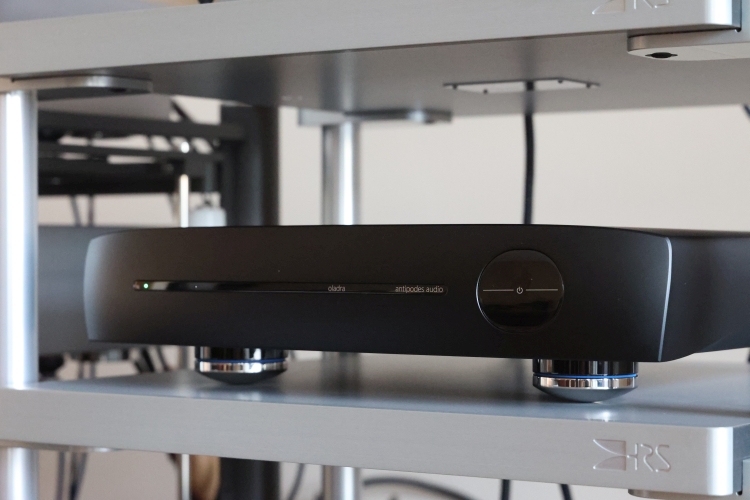
Some of us at the JPLAY forum have tested the JPLAY iOS app, via an RJ-45 cable, from the Audio Network router to a Lightning to Ethernet adapter, connecting the latter to the iPad or iPhone, with impressive results. If you still have the XACT S1, you might want to look into it. Carlos
You mentioned that the JPLAY for iOS app runs on iPads and iPhones, and although it is not officially endorsed for MacOS it runs perfectly fine on the original M1 MacBook Air as well.
Marcin told me that a Mx MacBook with JPLAY for iOS running on it can output directly via USB to DAC.
So it might be possible that this software gives the Macbook a nice uplift in SQ.
Did you try this?
Thanks
Hi Matt, Although it might indeed work and sound decent enough, I’d be hesitant to expect anything beyond that, given that the Macbook has no special power supply, audio interface, or USB hardware. Earlier experiments with several Windows PCs and my previous Intel Macbook Pro did not yield anything spectacular. That said, I have never used my current M1 MacBook with any of my DACs, so I don’t really know:-)
Thank you for your review, Christiaan. I appreciate that you’ve taken the time to evaluate the performance of both the player and server apps, especially noting the shift in hierarchy favoring UPnP/mpd. We previously discussed Squeeze + Squeeze, but unfortunately, it is not compatible with JPLAY. Additionally, your comparison with Taiko (though I understand you won’t review it), Oladra, and CDs helps put sound quality into perspective.
In a high-performing setup, we’re always eager to understand when and how the system performs at its best. You suggest that S1 may benefit from a complementary S1 running bespoke firmware to achieve optimal sound quality. Given the meticulous attention to detail—from the specially-selected industrial-grade 4TB SSD with the XACT Link drive cable to the highly durable OS SD card designed for military conditions—it seems clear that playing local files represents the pinnacle of sound quality in a single S1 unit, followed (closely) by streaming from Tidal or Qobuz.
Is that correct, or am I mistaken? If you did compare with differnent file types that also would be very interesting to know.
All the best,
Paul
Hi Paul, I’ve not heard the dual S1 setup. That part is added for information only.
The SQ delta between local and streaming depends on a few variables, an important one of which is the recording date. Recent files often sound better streaming than when ripped from a CD. For older albums, it can go both ways, especially when comparing originals with remasters. But under equal circumstances, more often than not, local is better.
When comparing purchased and downloaded Qobuz files, I tried WAV and FLAC but can’t be sure which is the master format. It could very well be FLACs, from which the WAVs are derived. In any case, in these particular circumstances, local WAV sounds best, followed by local FLAC, and then streaming. However, the differences are quite small, especially between local FLAC and streaming FLAC. Ultimately, I find I am very comfortable listening to either source or format, regardless of the small differences.
From all my switch reviews, I know they affect both streaming and local music playback. In other words, the music stream need not actually travel through the switch for the latter to have an effect on the sound.
Thank you for your response. I was already aware of your preference for WAV files and local storage, but I’m curious if this also applies specifically to the S1, given that Marcin emphasized the integration of the local SSD.
It seems we’re constantly at a crossroads between playing from local storage and streaming, with difference in sound quality often diminishing. However, in certain setups—and particularly with certain files like WAV—a noticeable difference can still be heard in 2024. Apologies if I misunderstood your point.
Hi Paul, to clarify, there is still an audible difference between local WAV and streaming FLAC, and this is audible with the Grimm, Antipodes, and XACT S1. The difference is smaller between local FLAC and streaming FLAC. And, sometimes, streaming can be better than a ripped CD. My stance is that the difference is not always large enough to warrant worrying about too much. Marcin is also a huge fan of DSD, and playing DSF files through XACT S1 was an important part of the fine-tuning process. For DSD playback, you obviously need local storage, which helps explain the emphasis.
That makes more sense to me now. I really appreciate it.
Thank you!
In addition to considering how a switch affects local file playback, we should also factor in (any) network noise from the modem all the way to the streamer and dac, and any connected devices, power supplies included.
In sensitive systems, even minor network noise can become noticeable. This might explain why disconnecting the Ethernet cable sometimes improves audio quality, although it’s not a practical solution if you prefer to use well-designed music apps and software.
Regarding file formats, besidesc using the WAV format, achieving optimal sound quality is often best with files that match the original sample rate and bit depth of the recording, provided you can determine those specifications.
Fantastic review, as always Christiaan. You are an asset to the audiophile community, keep up the great work 🙂
Thanks, Watts!
I own a Taiko, Should I sell It for the XCAT?
Given that I also work for Taiko Audio, I need to avoid a conflict of interest. So, I’m afraid I cannot comment on the Taiko Extreme.
Allow me to give it a try. Based on the review, it seems that the XACT S1 is a strong contender but if price isn’t a concern, it might not quite reach the level of the top-tier servers like the Antipodes Oladra or Taiko Audio Extreme.
That said, it’s an important question to consider. Also, do you currently own a Taiko + a network card + an Extreme Switch + an Extreme Router?
If you lean towards local files, Marcin (and likely Emile as well) have put considerable effort into optimizing local playback. What types of files do you typically play?
Ultimately, they each have distinct sound qualities, so your decision will come down to what suits your listening preferences best. Happy listening!
I own the USB card, a sotm switch with clk inside and a super clock sotm. I used sotm linear power supply for both and 2 Sotm Ethernet with filters cat7 and one stack audio Ethernet filter. My Dac is apl sr mk2, have kondo g700/melius Accu A80, TAD cr1tx
I assume you’re primarily focused on streaming, which makes sense given the attention you’ve paid to your network. Even upgrading the router’s power supply could make a difference.
Perhaps Christian could help you by identifying the distinct sound characteristics of the Taiko, Oladra, and XACT S1 without preference. If anyone can articulate the sometimes subtle audible differences between them, it’s him!
Thanks Paul, I have a Sotm power supply too on my internet box.
(-:
All I can say is that the two severs sound very different. One is not better than the other, but they do have different perspectives, making it a personal matter. Also, the two employ different music playback suites (UPnP/JPLAY and Roon). What I would recommend is to audition the XACT S1 next to the Extreme to form your own opinion.
Thanks Peter, I leave close to Lille, I think you too? If one day possible to make an audition. Edward is installing last version of XDMS at same time I make my email. I will saw what it will able to do
If you’re open to all possibilities and recognize the potential of networks and switches in high-end audio—especially after hearing it yourself—why not consider selling the Taiko for two XACT S1 units with a few recommended JCAT cables? It seems that “the XACT S1 can be paired with a second S1 to achieve the best sound quality. Of course first we keep waiting for further audible insights from Christiaan 😉
If I recall correctly, Marcin mentioned that he connects directly to the router (or box) and either disconnects his iPad or uses a wired connection. Given that, with a S1 combo you might also consider selling the SoTM switch with the internal clock, along with the Super Clock SoTM, SoTM linear power supply for both, two SoTM Ethernet cables with filters (Cat7), and one Stack Audio Ethernet filter.
Hello, Thank you for the marvelous reviews you provide! Always a pleasure to read them.
I bought a Weiss Helios DAC. It has not arrived yet. Meanwhile, I’m shopping for a server/streamer. The two that sound most compatible to me on paper are the K22 and now the Xact. Different profiles to be sure. I’ve heard the Oladra. So, I understand the house sound. But, I’ve not heard an Xact—and it’s likely that the only way to do this is to buy one. And so, I write to ask.
I have Pass xa60.8 monos and an XP-32 preamp. Like you’ve experienced, I’m trending away from the romantic and will replace them as I can, in favor of Gryphon Diablo 333.
I have Magico A5 speakers.
Which of these two streamers is the best match (short term or long term or both)?
Thank you in advance for your insight!
Hi John, honestly, it depends on your personal sonic preferences, as well as the software you want to use. Antipodes offers a complete software suite while the XACT S1 offers only UPnP. That said, the sonic differences will be a more decisive factor. Antipodes has an earthier and beefier, more full-bodied sound, especially the K22, while the XACT has an airier and more delicate sound. Although I have not directly compared the K22 with the XACT S1, I did review all Antipodes models, and know how they compare. The K22 offers great value for money, but is not quite as articulate, refined, or highly resolving as the Oladra or the XACT S1.
Thank you Christiaan (and Paul)! Those are all good things for me to consider.
“The two that sound most compatible to me on paper are the K22 and now the Xact.”
You’ve chosen a very advanced DAC with various inputs, so I think you should carefully consider which output you prefer from your server. The Xact can only output through USB, so you’ll be limited to that option. Additionally, the K22 is a medium-powered server, which might partially explain its more romantic sound signature. In contrast, the K50, being higher-powered, should sound more agile.
You didn’t mention whether you prefer streaming or local files, and that’s an important consideration too. Both servers perform best with local files streamed from a Samsung PM893 SSD (preinstalled in the Xact).
All Antipodes devices with digital outputs include an additional reclocking/regenerating stage compared to the USB output. The Oladra, however, has an extra reclocking/regenerating stage for both USB and digital outputs compared to the other devices.
Given your budget and sound preferences, you really should (at the very least) audition the Xact and a higher-end Antipodes model.
Would you kindly point out if hfa favourite is higher or lower than highly recommended
Many thanks
Hi Mark, That is an understandable question, which is answered in the intro on the Awards page. Basically, they have the same ranking, but Favorite components are actually part of my inventory, meaning they are also actively used.